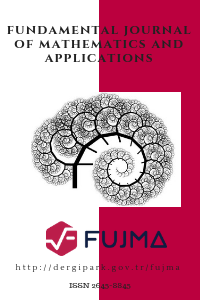Covariant and Contravariant Symbols of Operators on $l^{2}(\mathbb{Z})$
Covariant and Contravariant Symbols of Operators on $l^{2}(\mathbb{Z})$
In this paper, we investigate covariant and contravariant symbols of operators generated by a representation of the integer group $\mathbb{Z}$. Then we describe some properties (Existence, Uniqueness, Boundedness, Compactnessi and Finite rank) of these operators and reformulated some know results in terms of wavelet transform (covariant and contravariant symbols).
Keywords:
Bounded, Compact and finite rank operators, Covariant and contravariant symbols of operators Wavelet transformation,
___
- [1] F. A. Berezin, Covariant and contravariant symbols of operators, Izv. Akad. Nauk SSSR Ser. Mat., 36 (1972), 1134–1167.
- [2] F. A. Berezin, Wick and anti-Wick symbols of operators, Mat. Sb. (N.S)., 86 (128) (1971), 578–610.
- [3] F. A. Berezine, Method of Second Quantization, Nauka, Moscow, 1988.
- [4] F. A. Berezin, General concept of quantization, Comm. Math. Phys., 40 (1975), 153–174.
- [5] V. V. Kisil, Calculus of operators: covariant transform and relative convolutions, Banach J. Math. Anal., 8 (2) (2014), 156–184.
- [6] V. V. Kisil, Wavelets in Banach spaces, Acta Appl. Math., 59 (1) (1999), 79–109.
- [7] A. V. Balakrishnan, Applied Functional Analysis, volume 3 of Applications of Mathematics, Springer-Verlag, New York, second edition, 1981.
- [8] P. A. Fillmore, J. P. Williams, On operator ranges, Advances in Math., 7 (1971), 254-218.
- [9] I. Gohberg, S. Goldberg, M. A. Kaashoek, Basic classes of linear operators, Birkh auser Verlag, Basel, 2003.
- [10] A. W. Naylor, G. R. Sell, Linear operator theory in engineering and science, volume 40 of Applied Mathematical Sciences, Springer-Verlag, New York, second edition, 1982.
- [11] H. Fuhr, Abstract Harmonic Analysis of Continuous Wavelet Transforms, Springer-Verlag Berlin Heidelberg, 2005.
- [12] L. Debnath, P. Mikusinski, Introduction to Hilbert Spaces with Applications, Academic Press, Boston, 2, 1999.
- [13] V. V. Kisil, Erlangen Programme at Large: An Overview, In S. V. Rogosin and A. A. Koroleva (eds.) Advances in applied analysis, Birkh¨auser Verlag, Basel, 2012, pp. 1–94.
- [14] V. V. Kisil, Integral representations and coherent states, Bull. Belg. Math. Soc. Simon Stevin., 2 (5) (1995), 529–540.
- [15] S. T. Ali, J. P. Antoine, J. P. Gazeau, Coherent States, Wavelets and Their Generalizations, Graduate Texts in Contemporary Physics. Springer-Verlag, New York, 2000.
- [16] A. Perelomov, Generalized coherent states and their applications. Texts and Monographs in Physics, Springer-Verlag, Berlin, 1986.
- [17] F. A. Berezin, M. A. Shubin, The Schrodinger Equation, volume 66 of Mathematics and its Applications (Soviet Series). Kluwer Academic Publishers Group, Dordrecht, 1991.
- [18] V. V. Kisil, Covariant transforms, Journal of Physics: Conference Series., 284 (1) (2011), 12–38.
- [19] V. V. Kisil, Operator covariant transform and local principle, J. Phys. A: Math. Theor., 45 (2012), 1–10.
- [20] M. Garayev, S. Saltan, D. Gundogdu, On the inverse power inequality for the Berezin number of operators, Journal of Mathematical Inequalities., 12 (4) (2018), 997–1003.
- [21] J. R. Retherford, Hilbert Space: Compact Operators and the Trace Theorem, London Math. Soc. Monographs, Cambridge University Press Cambridge, 1993.
- [22] N. I. Akhiezer, I. M. Glazman, Theory of Operators in Hilbert Space, Pitman, Boston, I (1981), 254-218.
- [23] I. Chalendar, E. Fricain, M. G¨urdal, M. T. Karaev, Compactness and Berezin symbols, Acta Sci. Math., 78 (2012), 315-329.
- [24] M. T. Karaev, M. Gurdal, U. Yamancı, Special operator classes and their properties, Banach J. Math. Anal., 7 (2) (2013), 75-86.
- ISSN: 2645-8845
- Yayın Aralığı: Yılda 4 Sayı
- Başlangıç: 2018
- Yayıncı: Fuat USTA
